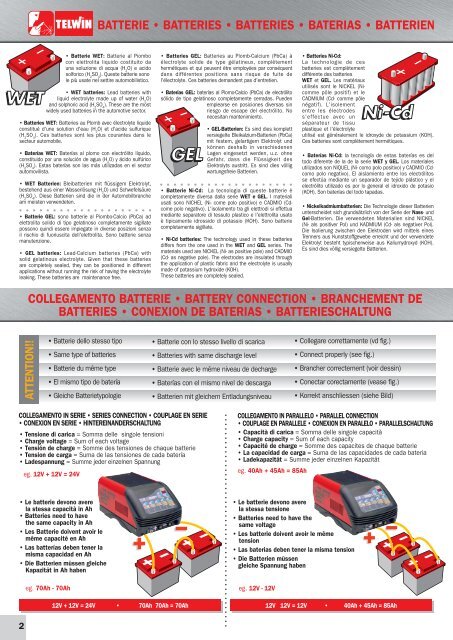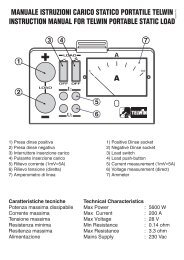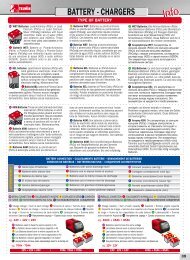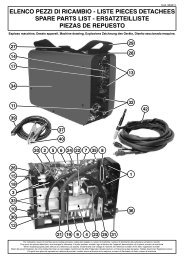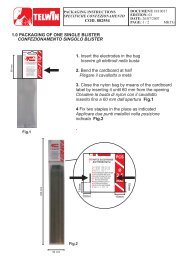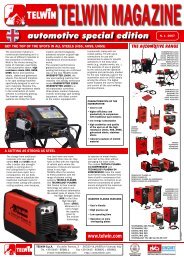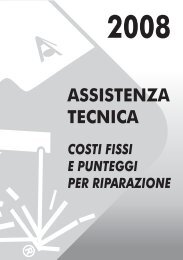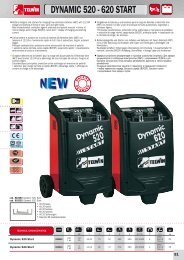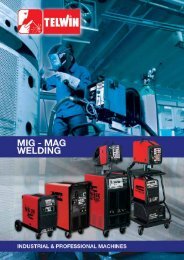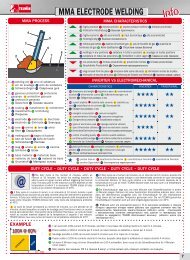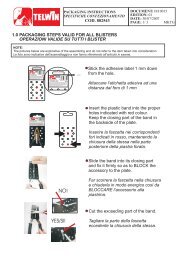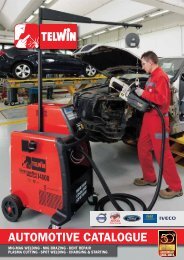startronic 300 - Telwin
startronic 300 - Telwin
startronic 300 - Telwin
You also want an ePaper? Increase the reach of your titles
YUMPU automatically turns print PDFs into web optimized ePapers that Google loves.
BATTERIE • BATTERIES • BATTERIES • BATERIAS • BATTERIEN<br />
• Batterie WET: Batterie al Piombo<br />
con elettrolita liquido costituito da<br />
una soluzione di acqua (H 2<br />
O) e acido<br />
solforico (H 2<br />
SO 4<br />
). Queste batterie sono<br />
le più usate nel settire automobilistico.<br />
• WET batteries: Lead batteries with<br />
liquid electrolyte made up of water (H 2<br />
O)<br />
and solphoric acid (H 2<br />
SO 4<br />
). These are the most<br />
widely used batteries in the automotive sector.<br />
• Batteries WET: Batteries au Plomb avec électrolyte liquide<br />
constitué d'une solution d'eau (H 2<br />
O) et d'acide sulfurique<br />
(H 2<br />
SO 4<br />
). Ces batteries sont les plus courantes dans le<br />
secteur automobile.<br />
• Baterías WET: Baterías al plomo con electrólito líquido,<br />
constituido por una solución de agua (H 2<br />
O) y ácido sulfúrico<br />
(H 2<br />
SO 4<br />
). Estas baterías son las más utilizadas en el sector<br />
automovilista.<br />
• WET Batterien: Bleibatterien mit flüssigem Elektrolyt,<br />
bestehend aus einer Wasserlösung (H 2<br />
O) und Schwefelsäure<br />
(H 2<br />
SO 4<br />
). Diese Batterien sind die in der Automobilbranche<br />
am meisten verwendeten.<br />
• Batterie GEL: sono batterie al Piombo-Calcio (PbCa) ad<br />
elettrolita solido di tipo gelatinoso completamente sigillate<br />
possono quindi essere impiegate in diverse posizioni senza<br />
il rischio di fuoriuscita dell'elettrolita. Sono batterie senza<br />
manutenzione.<br />
• GEL batteries: Lead-Calcium batteries (PbCa) with<br />
solid gelatinous electrolyte. Given that these batteries<br />
are completely sealed, they can be positioned in different<br />
applications without running the risk of having the electrolyte<br />
leaking. These batteries are maintenance free.<br />
• Batteries GEL: Batteries au Plomb-Calcium (PbCa) à<br />
électrolyte solide de type gélatineux, complètement<br />
hermétiques et qui peuvent être employées par conséquent<br />
dans différentes positions sans risque de fuite de<br />
l'électrolyte. Ces batteries demandent pas d'entretien.<br />
• Baterías GEL: baterías al Plomo-Calcio (PbCa) de electrólito<br />
sólido de tipo gelatinoso completamente cerradas. Pueden<br />
emplearse en posiciones diversas sin<br />
riesgo de escape del electrólito. No<br />
necesitan mantenimiento.<br />
• GEL-Batterien: Es sind dies komplett<br />
versiegelte Bleikalzium-Batterien (PbCa)<br />
mit festem, gelartigem Elektrolyt und<br />
können deshalb in verschiedenen<br />
Lagen eingesetzt werden, u.z. ohne<br />
Gefahr, dass die Flüssigkeit des<br />
Elektrolyts austritt. Es sind dies völlig<br />
wartungsfreie Batterien.<br />
• Batterie Ni-Cd: La tecnologia di queste batterie è<br />
completamente diversa dalla serie WET e GEL. I materiali<br />
usati sono NICHEL (Ni- come polo positivo) e CADMIO (Cdcome<br />
polo negativo). L'isolamento tra gli elettrodi si effettua<br />
mediante separatore di tessuto plastico e l'elettrolita usato<br />
è tipicamente idrossido di potassio (KOH). Sono batterie<br />
completamente sigillate.<br />
• Ni-Cd batteries: The technology used in these batteries<br />
differs from the one used in the WET and GEL series. The<br />
materials used are NICKEL (Ni- as positive pole) and CADMIO<br />
(Cd- as negative pole). The electrodes are insulated through<br />
the application of plastic fabric and the electrolyte is usually<br />
made of potassium hydroxide (KOH).<br />
These batteries are completely sealed.<br />
• Batteries Ni-Cd:<br />
La technologie de ces<br />
batteries est complètement<br />
différente des batteries<br />
WET et GEL. Les matériaux<br />
utilisés sont le NICKEL (Nicomme<br />
pôle positif) et le<br />
CADMIUM (Cd- comme pôle<br />
négatif). L'isolement<br />
entre les électrodes<br />
s'effectue avec un<br />
séparateur de tissu<br />
plastique et l'électrolyte<br />
utilisé est généralement le idroxyde de potassium (KOH).<br />
Ces batteries sont complètement hermétiques.<br />
• Baterías Ni-Cd: la tecnología de estas baterías es del<br />
todo diferente de la de la serie WET y GEL. Los materiales<br />
utilizados son NIQUEL (Ni- como polo positivo) y CADMIO (Cdcomo<br />
polo negativo). El aislamiento entre los electrólitos<br />
se efectúa mediante un separador de tejido plástico y el<br />
electrólito utilizado es por lo general el idroxido de potasio<br />
(KOH). Son baterías del todo tapadas.<br />
• Nickelkadmiumbatterien: Die Technologie dieser Batterien<br />
unterscheidet sich grundsätzlich von der Serie der Nass- und<br />
Gel-Batterien. Die verwendeten Materialien sind NICKEL<br />
(Ni- als positiver Pol) und KADMIUM (Cd- als negativer Pol).<br />
Die Isolierung zwischen den Elektroden wird mittels eines<br />
Trenners aus Kunststoffgewebe erreicht und der verwendete<br />
Elektrolyt besteht typischerweise aus Kaliumydroxyd (KOH).<br />
Es sind dies völlig versiegelte Batterien.<br />
COLLEGAMENTO BATTERIE • BATTERY CONNECTION • BRANCHEMENT DE<br />
BATTERIES • CONEXION DE BATERIAS • BATTERIESCHALTUNG<br />
ATTENTION!!<br />
• Batterie dello stesso tipo<br />
• Same type of batteries<br />
• Batterie du même type<br />
• El mismo tipo de batería<br />
• Gleiche Batterietypologie<br />
• Batterie con lo stesso livello di scarica<br />
• Batteries with same discharge level<br />
• Batterie avec le même niveau de decharge<br />
• Baterías con el mismo nivel de descarga<br />
• Batterien mit gleichem Entladungsniveau<br />
• Collegare correttamente (vd fig.)<br />
• Connect properly (see fig.)<br />
• Brancher correctement (voir dessin)<br />
• Conectar corectamente (vease fig.)<br />
• Korrekt anschliessen (siehe Bild)<br />
COLLEGAMENTO IN SERIE • SERIES CONNECTION • COUPLAGE EN SERIE<br />
• CONEXION EN SERIE • HINTEREINANDERSCHALTUNG<br />
• Tensione di carica = Somma delle singole tensioni<br />
• Charge voltage = Sum of each voltage<br />
• Tensión de charge = Somme des tensiones de chaque batterie<br />
• Tension de carga = Suma de las tensiones de cada batería<br />
• Ladespannung = Summe jeder einzelnen Spannung<br />
eg. 12V + 12V = 24V<br />
COLLEGAMENTO IN PARALLELO • PARALLEL CONNECTION<br />
• COUPLAGE EN PARALLELE • CONEXION EN PARALELO • PARALLELSCHALTUNG<br />
• Capacità di carica = Somma delle singole capacità<br />
• Charge capacity = Sum of each capacity<br />
• Capacité de charge = Somme des capacites de chaque batterie<br />
• La capacidad de carga = Suma de las capacidades de cada bateria<br />
• Ladekapazität = Summe jeder einzelnen Kapazität<br />
eg. 40Ah + 45Ah = 85Ah<br />
• Le batterie devono avere<br />
la stessa capacità in Ah<br />
• Batteries need to have<br />
the same capacity in Ah<br />
• Les Batterie doivent avoir le<br />
même capacité en Ah<br />
• Las batterías deben tener la<br />
misma capacidad en Ah<br />
• Die Batterien müssen gleiche<br />
Kapazität in Ah haben<br />
eg. 70Ah - 70Ah<br />
• Le batterie devono avere<br />
la stessa tensione<br />
• Batteries need to have the<br />
same voltage<br />
• Les batterie doivent avoir le même<br />
tension<br />
• Las baterias deben tener la misma tension<br />
• Die Batterien müssen<br />
gleiche Spannung haben<br />
eg. 12V - 12V<br />
12V + 12V = 24V • 70Ah 70Ah = 70Ah 12V 12V = 12V • 40Ah + 45Ah = 85Ah<br />
2


